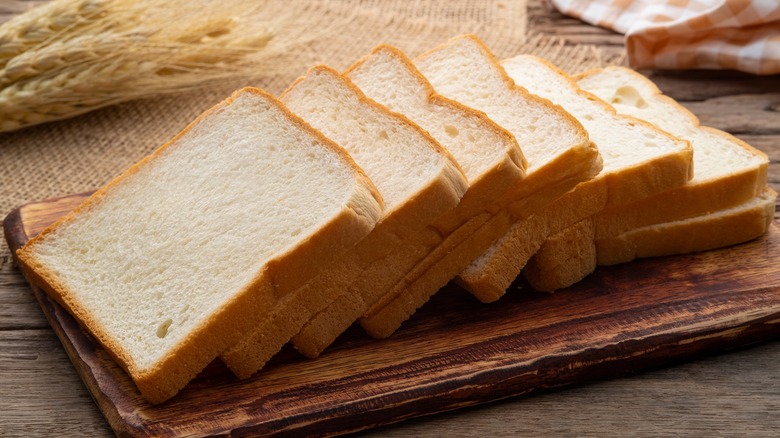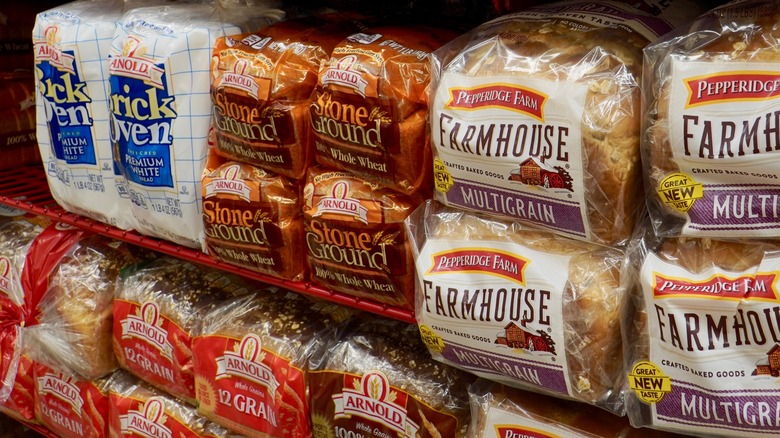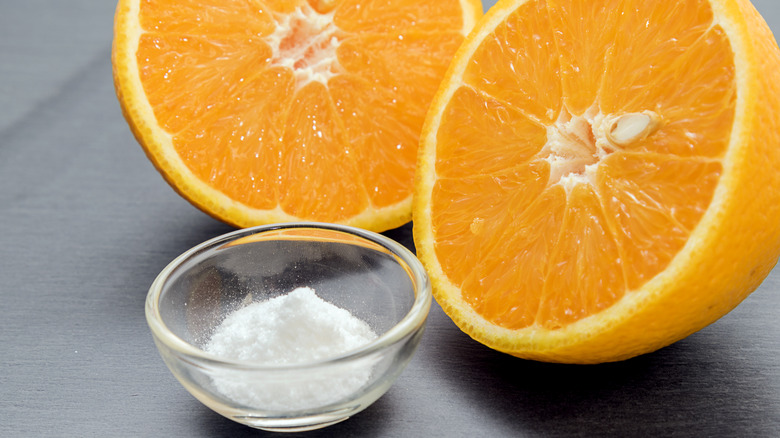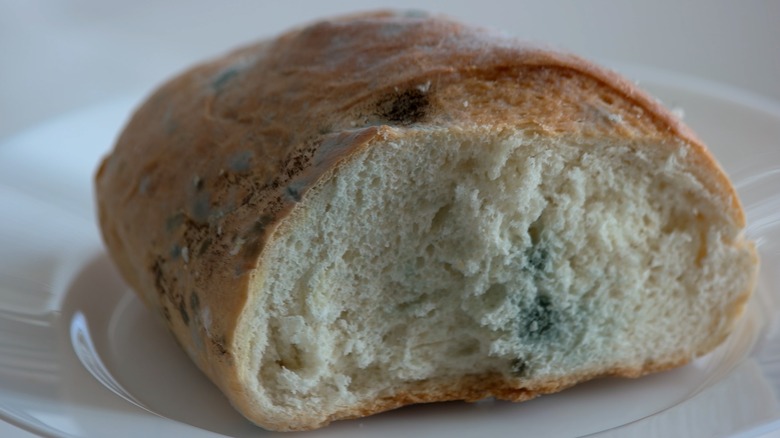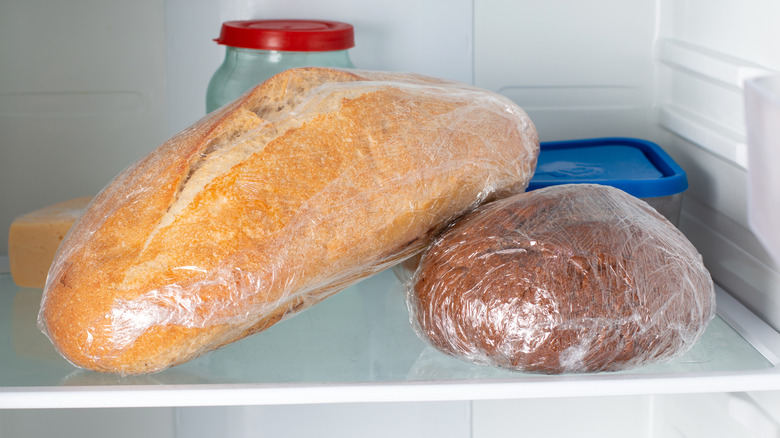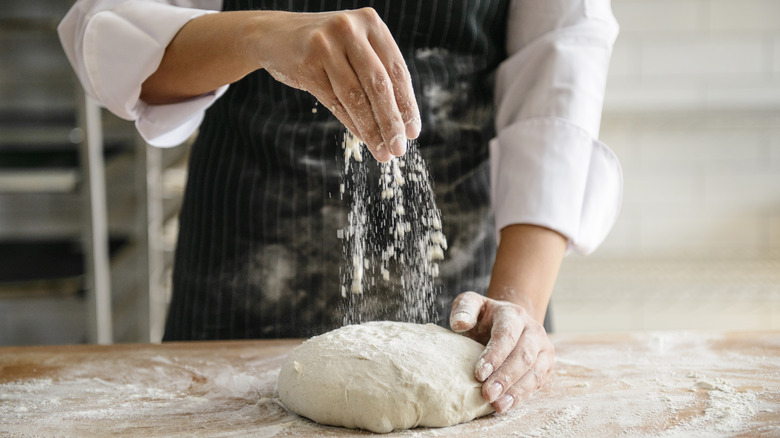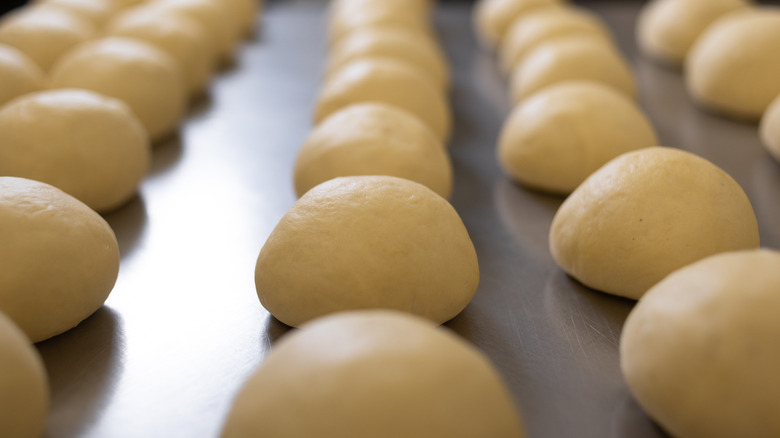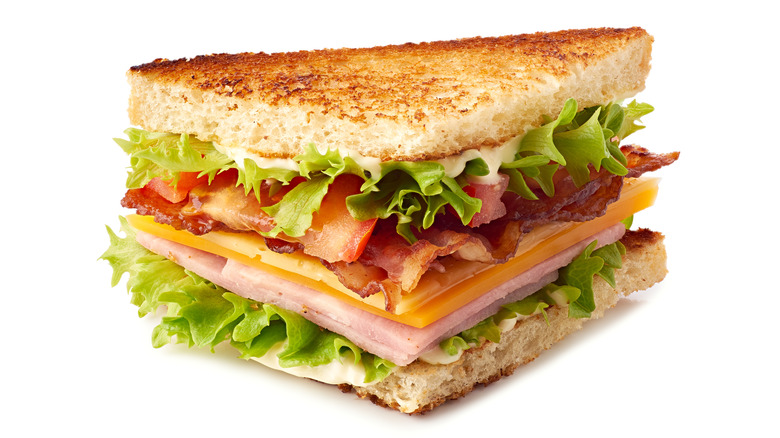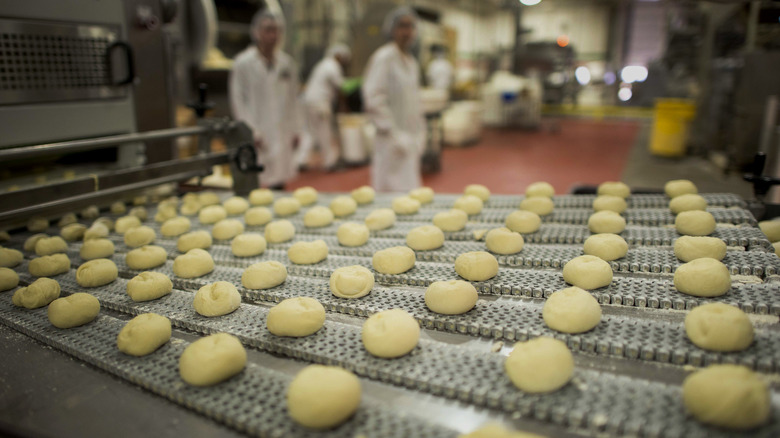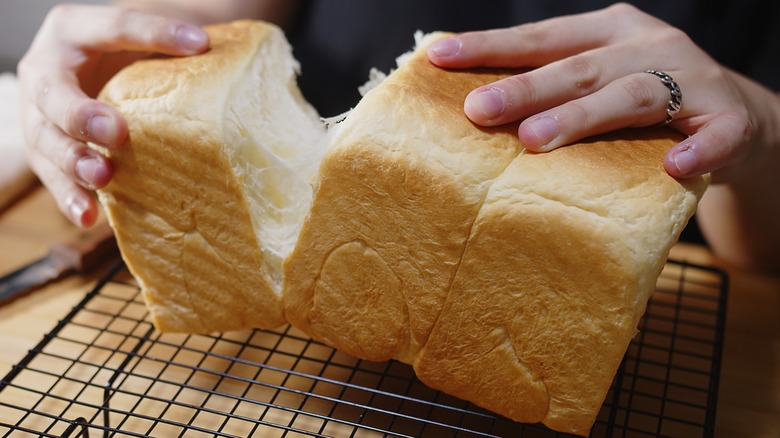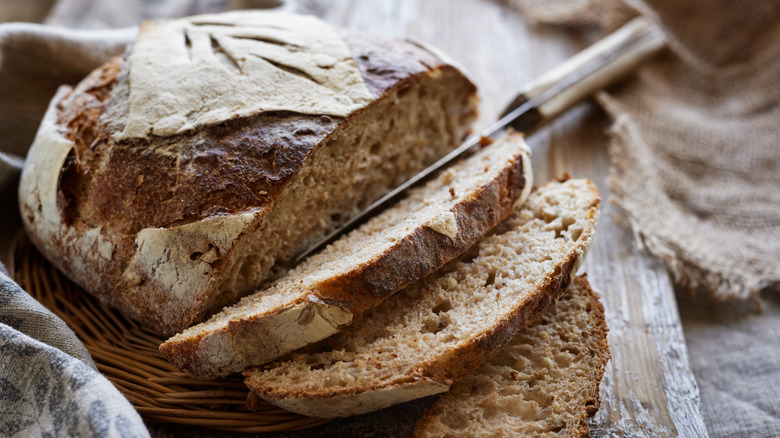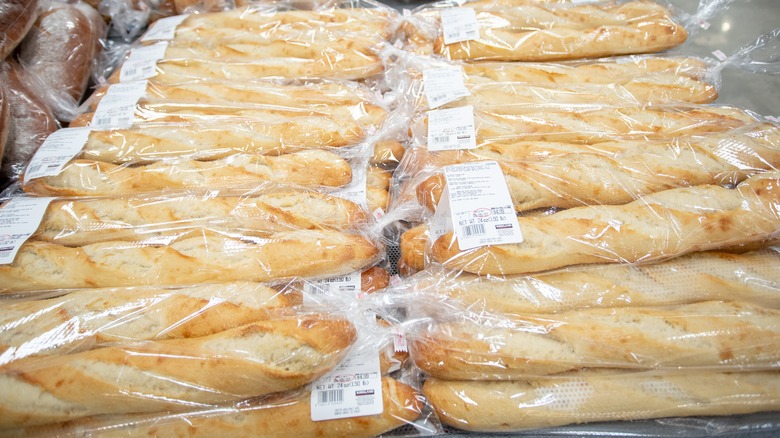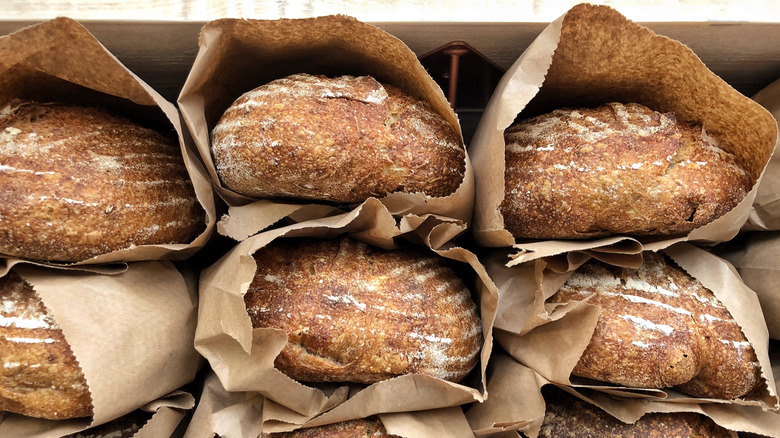Here's The True Difference Between Sandwich Bread And Real Bread
We may receive a commission on purchases made from links.
An earlier version of this article neglected to include the potential for additives in grocery store artisan bread. Corrected on 1/26/2023.
Two square, fluffy pieces of bread made to hold all of your favorite sandwich contents. It's almost as if ... they were meant to hold everything in place? Meanwhile, you've got your bread that isn't that, let's call it "real bread." You know the kind, found in your local grocery store bakery, some deemed artisanal, some just well, as regular as a loaf of bread can get. Sourdough, rye, baguette, rolls, and Italian bread are just some that can fall under this category.
But there are a couple of differences between sandwich bread and real bread, and the culinary goal you're trying to achieve can play a role in which you'll select on your next food shopping trip. You have more likely than not been irritated at how fast real bread hardens and is no longer useful unless you're making breadcrumbs.
From the shelf life of real bread versus the seemingly unnaturally long shelf life of most sandwich breads, they both serve their own purpose. From expiration dates to how quickly a bread develops mold, there's a science to the baking process for both, as well as preparation alterations and varying ingredients. So here's the true difference between sandwich bread and real bread.
Real bread and sandwich bread ingredients differ
First thing is first, sandwich bread and real bread are made differently. Although some type of wheat is present in both, their jobs to the consumer differ and so does their culinary makeup. Let's look at the nutrition label on a package of a popular sandwich bread brand known as Arnold, a leading product of Bimbo Bakeries (courtesy of their website). Arnold's Country Style White contains enriched wheat flour, water, sugar, whey, yeast, butter, sea salt, cultured wheat flour, vegetable oil, soy lecithin, grain vinegar, citric acid, and wheat gluten, according to Stop and Shop.
If you're looking at an artisanal loaf of bread from a bakery, flour, yeast, salt, water, and seasonings are used, according to Fast Easy Bread. Grocery store loaves that may appear artisanal could be mass-produced, in which case additives and dough conditioners are added since they have a faster turnaround. Breads like baguette, ciabatta, and sourdough make up this category. Dough that is mass-produced needs to be compatible with a bread factory's machinery, whereas ingredients like seeds or nuts that may be added to artisanal breads made by hand aren't suitable for the milling process, we learn via Great Food Club.
Sandwich bread is produced to last weeks long, resisting mold
You may purchase sandwich bread from a grocery store for its shelf life. It can be annoying when the clock is ticking on your real bread and you've barely put it to use. Unless you're planning to repurpose that bread for a delicious, mouthwatering traditional bread pudding, you won't be left with other options that don't require you to soak it to save it. There is a reason sandwich bread lasts longer than real bread, and that's because it is produced with the time factor in mind.
A key ingredient found in most commercial sandwich bread is ascorbic acid. According to Chainbaker, ascorbic acid, simply known as vitamin C, is not only a collagen-building supplement for the human body, but can also enhance the shelf life of sandwich bread (via Mayo Clinic.) This ingredient makes this carbohydrate pack a tighter crumb than its real counterpart does, and ascorbic acid also contributes to its finer texture. Using ascorbic acid is cost-effective for companies who mass produce breads, as it amplifies the dough's volume. Making more while having each loaf last longer is lucrative for the commercial sandwich bread industry.
Real bread just isn't made to last
If you've wondered why the bread gods are seemingly never on your side when storing bread to keep it fresh, here's some humbling news: real bread just isn't made to last. While it's possible to store it accordingly based on what ingredients your bread is composed of, it won't maintain the quality sandwich bread flaunts for weeks on end.
According to the USDA, commercially baked rolls and breads can be placed at room temperature for up to four days. They may last up to 14 days if they are refrigerated, and if they contain meat or eggs, they're best kept in the fridge within two hours of purchase. While it's possible to freeze bread for months, let's face it — it doesn't have quite the same effect on your carbohydrate-craving taste buds as fresh bread baked that morning. Refrigeration can also have a reverse effect and make bread go stale.
Real bread is also prone to molding depending on climate, according to MasterClass. Humidity is a cause of bacteria buildup. If your bread is three to four days old, it will be much drier in texture. Though sourdough bread boasts a longer shelf life than other types, this is thanks to the presence of lactic acid bacteria. In turn however, it can also develop mold more quickly due to its acidity.
Retrogradation makes real bread go stale quicker
On the outside, bread that has gone stale might appear as overly dry and now inedible. But there is much more going on in your bread when it is finally turned to stone, all the way down to a granular level. This process is known as retrogradation.
When bread is placed in a cold environment like a fridge, its starches try to go back to their crystal form, we learn from the Los Angeles Times. When preparing a bread dough, wheat flour is used, which is made up of starch granules packed together. These granules separate when the wheat flour is blended with water.
However, after bread has been baked, its natural inclination is to go back to its original form by recrystallizing its starch granules. While cold temperatures make this process happen quicker (starting at 40 degrees) this is why refrigerating bread can make it go stale, as the average fridge is set to this temperature. This is why toasting bread is a temporary fix to recrystallized starches, as the heat allows them to go back to a looser form. Strangely enough, freezing bread makes retrogradation happen much slower — it's the reason why freezing can be a great alternative if you're in a pinch.
Both types of bread have different kneading techniques
Sandwich bread and real bread, you can imagine, do not exactly have identical preparation methods. One vital step taken before the bread hits the oven is kneading. Because of the volume at which sandwich bread is produced, kneading becomes a mechanical process — whereas real bread can be kneaded by hand in smaller batches.
When it comes to sandwich bread, there are more than a couple of things bread factories have to keep their eyes on while the dough kneads. According to a video by BAKERpedia, mixing time, maintaining an appropriate dough temperature, and energy input all need equal attention. An industrial bread mixer's speed and arm design also come into play. Vertical, spiral, planetary, and other settings are used when making dough at such high volume, though that's also dependent on the weight of the dough produced at a time.
As for real bread, kneading by hand can be tricky. Over-kneading can lead to too-tough of a texture, and not enough kneading will cause a lack of air bubbles essential for proper proofing (via Safe Food Factory.) As dough used for artisanal bread is often higher in hydration, a dough sticky to the touch can create a mess, according to King Arthur Baking. And although stand mixers exist, kneaded dough still needs extra attention.
The higher gluten content of sandwich bread makes the dough tougher
You may have noticed that sandwich bread feels quite literally more glutinous than real bread might. Be it its elasticity, its ability to soften when applied the slightest pressure from sandwich-eating fingers, and its ability to form into a ball if it is pressed into one.
Sandwich bread needs more gluten to serve its role as sandwich filling holder, and the ascorbic acid found in it strengthens its gluten structure allowing it to withhold more gas from fermentation, according to Chainbaker. During the kneading process of bread dough, gluten is brought to life, and elasticity is formed when the blended ingredients take in moisture, according to Safe Food Factory. When proofed, this is another chance for the bread's gluten to become more elastic as it doubles in size.
Gluten contributes to bread dough's volume and height. Ascorbic acid still remains gluten's partner in crime, and it's especially vital that this ingredient is present for dough where ancient wheat species are used, such as spelt and emmer. This is attributed to those types of wheat having less gluten, whereas bread dough is much stronger (via My German Table.)
Sandwich bread came much later
Commercial sandwich bread, in all of its sliced wonderful-ness, came about a little less than 100 years ago, when Otto Rohwedder thought of the idea. From Iowa, Rohwedder thought it would be convenient for sandwich bread to come sliced when purchased, we learn from Mental Floss.
He built a bread-slicing machine, which could only handle one loaf at a time. Most commercial bakers were not excited about the idea, concerned that the bread would go stale if it were pre-sliced. To remedy this, Rohwedder applied pins to hold the slices of bread uniformly, but as this created difficulty in handling, he decided on another method: wrapping each slide in waxing paper individually to keep them from going hard.
By 1930, the idea of sliced bread, though rejected a few more times by commercial bakers, caught on like wildfire. Wonder Bread became popular due to Rohwedder's genius. Sliced bread was later banned in 1943 as products like wax paper needed to be used moderately, and weaponry production was prioritized over sliced bread. Soon after, due to public outcry, it was brought back.
Sandwich bread rises much more quickly than real bread
If there is one thing about bread for sure, it's that you can't rush the rising process. However, you can cut time to make it more efficient. Due to the high volume at which sandwich bread is produced, its rising process has to be faster than a fresh loaf you would get at a lower-volume bakery. So how is this achieved in a sandwich bread-making facility?
There may still be more than one stage of proofing in a bread factory, and the first proof is to activate the yeast. Contrary to real bread, this bread is proofed for less time. According to a video by the Bakers Federation, this first stage can take a little under 10 minutes. Later the bread is rolled on a conveyor belt so that air bubbles are pushed out of the dough. Then it's rolled into the desired shape before reaching its final proofing station, typically in a tin. A warmer setting is essential for the bread to proof properly, which happens in around 50 minutes.
As for real bread, proofing at a cool temperature can yield the best results, we learn from Cook's Illustrated. Though proofing a dough in the fridge can create a beautiful end result with a chewy texture, this can take up to 24 hours.
Both types of bread use different methods to achieve fluffiness
It is very true that both good commercial sandwich bread and real bread provide some fluffiness. Though how is this achieved when they undergo different preparation methods? Well, it's all in the ingredients.
Sandwich bread has a few companions helping its fluff factor. According to Foodly, fats are notable in adding softness to breads, and in most sandwich bread brands, you'll find vegetable oil. Such an ingredient helps gluten tenderize and lubricate, rendering it soft and giving it moisture. Browning temperature is also lowered, keeping the softness of the bread while making sure the crust doesn't get brittle. Enzymes in this type of bread are added in by manufacturers, and this makes dough hang on to gas, in turn creating a light-weight slice. This is also known as dough conditioning, we learn from Gold Medal Bakery.
With real bread, the process can be similar (adding a fat like butter to make it softer), though ingredients like enzymes and emulsifiers may not be added. Commercial bread companies might add those to help to keep the dough's oil and water from separating. Adding emulsifiers might not be something a bakery would do, for instance, even though this helps with dough softening.
True artisan breads develop flavor further
Sandwich bread is pretty predictable. Let us explain. When you're at your favorite grocery store and looking forward to purchasing a specific commercial sandwich bread brand you have tried before, it's going to taste identical to the way it did when you first bought it. Odds are that is why you keep going back for it.
True artisanal breads are made by hand in small batches. Time is on the baker's side, and each loaf is unique. When dough is allowed all the time it needs to fully ferment, flavor inevitably has more time to develop too, we learn from Fast Easy Bread. This is why there's an array of artisan bread types, as fermentation length creates different flavors, textures, and savory notes as time goes by. Though commercial sandwich bread might not taste bad, it ultimately doesn't carry much flavor on its own. It's usually bland to accommodate different sandwich fillings, both savory and sweet.
Sugar, milk, eggs, and butter aren't necessary for bread-making, but may also be found in artisan breads like brioche, providing them with a richness not found in store-bought sandwich bread, according to Medina Baking. Following traditional techniques that don't need as much attention to time, dough pressure, and the use of specific ingredients, artisan bread allows for more creativity.
Some real grocery store bread might be previously frozen
You are in your local grocery store's bakery aisle, and the scent of freshly baked bread is giving your wallet a run for its money. You are confident that this bread quite literally hopped out of the oven just seconds ago. Turns out, the loaf now sitting in your shopping cart was most likely frozen at some point, according to Kitchenroar. But never fret — this is not necessarily a bad thing.
You will be surprised to find that this is not detrimental to your bread. Due to grocery stores refrigerating breads right after they come out of the oven, the bread is able to retain its quality without over-drying. Wrapping the goods with clear plastic wrap and storing them on shelves also discourages bacteria from entering them, which is essential to stores that sell bread all day, and their goal of avoiding food waste. However, it is possible that grocery store artisan bread contains additives that a local baker would not use.
Past Costco employees who have worked in their bakery section explain via Reddit which of their items come frozen and which do not. Bagels, artisan buns, and baguettes come frozen and are later baked onsite, while multigrain bread, country French bread, and a couple more flavored breads are made from scratch.
Real bread is often stored in brown paper bags and sandwich bread in plastic
Though you may have not noticed, real bread isn't stored the same way as sandwich bread at the grocery store. Commercial sandwich bread usually comes in a clear plastic bag, while real bread lies in a thin brown paper bag that gives a crunchy sound at your touch. The packaging may include some plastic, but in brown paper bags, the bread typically protrudes out a bit. So why is this?
Since fresh bread is best eaten within a few days of baking, it's placed in brown paper bags to allow more airflow, according to Mental Floss. This airflow would not happen if it were condemned to a plastic bag, as air is trapped and moisture is kept in place. However, this does contribute to sandwich bread's overall fluffy texture. Sometimes, paper bags are dotted with tiny holes to encourage more airflow, giving fresh bread a nice crust without drying it out.
Another reason why sandwich bread lasts so long is due to its storage in a plastic bag, which also prevents mold from building up. If bread is not meant to last more than a couple of days suffocated in the tight space of a plastic bag, its crinkling, crumbly factor would be lost to unwanted sogginess in its interior.
